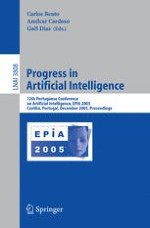2005 | Buch
Progress in Artificial Intelligence
12th Portuguese Conference on Artificial Intelligence, EPIA 2005, Covilhã, Portugal, December 5-8, 2005. Proceedings
herausgegeben von: Carlos Bento, Amílcar Cardoso, Gaël Dias
Verlag: Springer Berlin Heidelberg
Buchreihe : Lecture Notes in Computer Science
